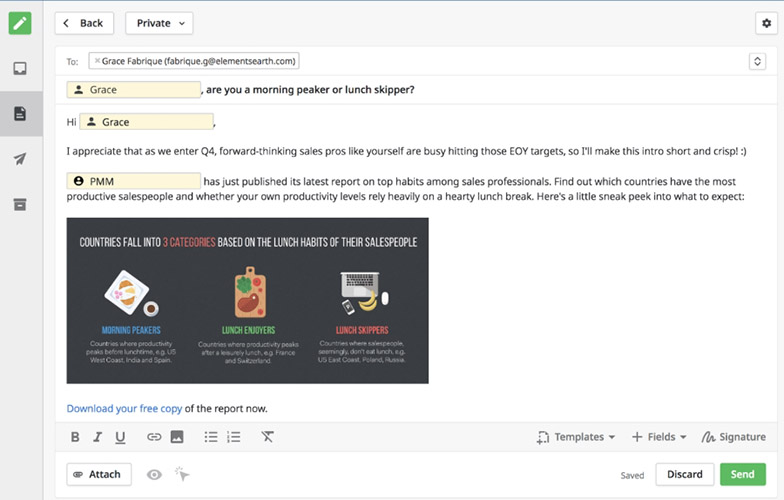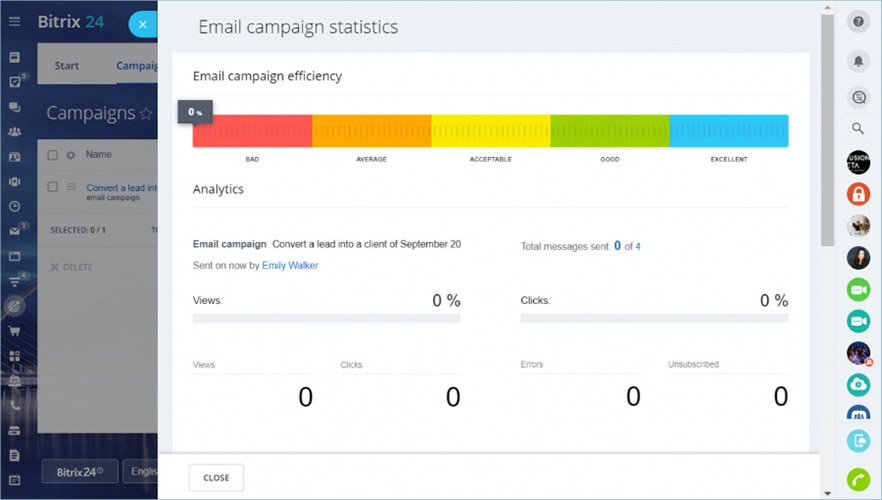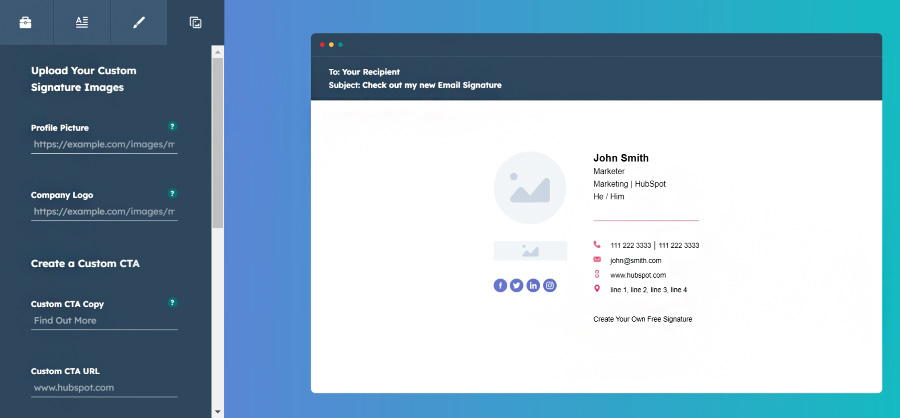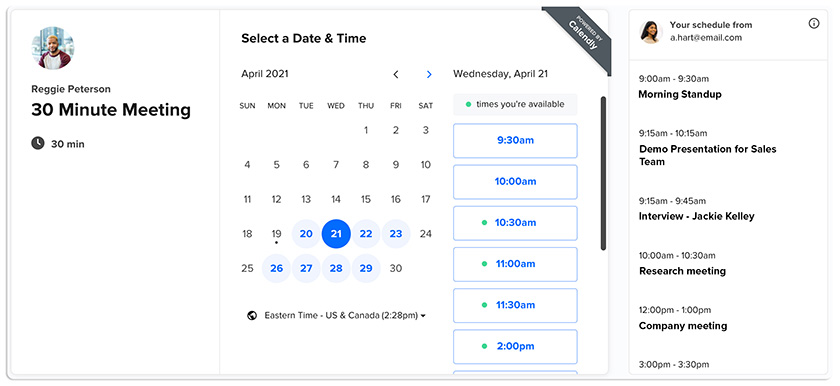Sales emails allow you to send information intended to generate leads or move a lead through the pipeline and address common objections from prospects. In our expert guide, we explain how to write a sales email in seven steps. These include determining sales objectives, researching email recipients, creating engaging subject lines, and initiating a call to action. We also give you persuasive sales email examples and sales email best practices.
1. Determine Your Sales Email Objective
To craft the best sales email, you must have a clear purpose for sending it in terms of a measurable objective. This provides a quantifiable system for what qualifies a “win” and impacts your email’s subject line, unique selling proposition, and call to action. While learning how to write a good sales email, take note of the following objectives:
- Gauging interest: Make a brief introduction to provide basic information about your business and solutions, and measure success with opens, clicks, or positive responses.
- Setting appointments: Persuade the lead to agree to a sales presentation or product demo and measure success by the number of appointments set.
- Qualify a lead: See if a lead is a good fit for your products or services and is interested in learning more. Success can be measured by marketing qualified leads (MQL) or sales qualified leads (SQL) generated.
- Send pricing: Make introductions to see if a lead is interested in getting pricing for your products or services and measure success by the number of pricing quotes or business proposals requested.
Pro tip: Create and store effective sales email templates for each objective so you and your team can easily plug and play as needed. Customer relationship management (CRM) software like Pipedrive lets you design email templates within the system and then store them so other users can have access.

Pipedrive email sales template with embedded image and file attachment (Source: Pipedrive)
2. Research Email Recipients for Sales Outreach Emails
As part of your overall sales plan, you may have an audience in mind for the types of leads and prospects you want to target. Just as you would with cold calling, you should conduct research on the individual contacts you plan on sending your email message. Doing this allows you to assess things like relevance, decision-making authority, and budget capacity.
This part is particularly important for making sure a recipient is the correct person to reach out to and to personalize opening lines for higher open and response rates. The website of the company the recipient works for and their LinkedIn profile are good sources of information for this step. As you do your research, ask yourself these questions about the recipient that will be useful in the next steps of how to write a sales email:
- Is the contact person the decision-maker for what you’re trying to sell, or can they redirect you to the correct person?
- Does the contact have any recently published content you can reference in your messages, such as an article, podcast, panel discussion, or webinar?
- Is there any recent news story that includes the contact or something the contact might be interested in hearing about?
- Do you have any connection with the client, such as the same alma mater, former occupation or employer, mutual friend or colleague, or interest in the same sports teams?
Pro tip: Have a strong grasp of the best recipients of your email for sales by creating customer profiles. Customer profiles offer a snapshot of your ideal buyer types based on demographic, behavioral, and interest-based information. Organizing this type of data into profiles helps you develop your messaging based on what the buyer’s priorities are likely to be.
3. Create Engaging Subject Lines
The subject line is a critical component of whether or not your sales outreach email will be opened by the recipient. It’s also used to indicate whether the message is considered spam in the eyes of the email system, so it needs to be constructed with care. When learning how to write a professional sales email, remember these two major elements of an engaging subject line:
- It mentions something personal, familiar, or relevant to the recipient
- It uses standout words you may not ordinarily see in an email message
For instance, let’s say you are attempting to schedule a product demonstration with an information technology (IT) security manager. You want to showcase your software, which gives users single-page system visibility for all devices, sessions, and workstations on a corporate network (something useful to a security manager). Your subject line could be something like:
Subject: Officially Declaring [Company name]’s Network Visible to [Recipient’s name]
This example uses something personal and relevant to the recipient three times (company name, network visibility, and recipient name) while also stating “Officially Declaring,” a unique series of words that stand out to the reader.
Another route to explore with subject lines is expressing urgency. Urgent subject lines work best for promotional sales and limited-time offers (LTOs). For example, if your human resources (HR) consulting business is offering free consultations on organizational culture for the next month, to set appointments, your subject could be something like:
Subject: We Don’t Want [Recipient’s name] to Miss Out on a Free Culture Consultation
There’s also the idea of using questions in subject lines, where the answer leads the recipient of your sales email to become interested in the rest of the message. Using the same HR consulting example, the subject could be:
Subject: Is [Recipient’s name] Looking to Improve [Company name]’s Culture but Doesn’t Know Where to Start?
4. Personalize the Opening Line & Introduce Yourself
Once you’ve constructed an engaging subject line to pique the recipient’s interest, you need a standout opening line to keep the momentum going. The opening line should be personalized based on your research in step two. If you found anything worth citing, add it to the first few sentences to show the contact you took the time and effort.
Here are a few excellent ways to begin your sales email message along with examples:
- Cite a mutual connection: Hi [Recipient’s name]! I saw we share a mutual connection to [person you share it with] through [links such as LinkedIn, friendship, or same organization], so I wanted to reach out personally.
- Compliment the recipient on recent work: Hi [Recipient’s name]! I saw your recent [content such as an article, webinar, interview, podcast, and so forth] on [content topic/subject] and found it impressive—nice work!
- Highlight a recent event: Hi [Recipient’s name]! As you may have seen in the news lately, businesses in the [industry] like yours could be seeing a lot of changes in [function that will be seeing changes]. That said, I wanted to make a personal introduction about what we do.
- Touch on a mutual interest: Hi [Recipients’ name]! I couldn’t help but notice we are both [university/college] alumni. Small world, but I always look to connect with fellow [university/college mascot].
- Address a mutual membership: Hi [Recipient’s name]! I see you are a fellow member of [mutual organization], so I wanted to make a personal introduction.
Following the opening line, introduce yourself. Offer a brief description of who you work with, what you do in terms of the value you offer (see below), and how you do it.
5. Pitch Your Value Proposition
Next, provide information on how you can help the recipient. This part of the email answers the question “why,” as in, why should the recipient fulfill your objective? Ideally, your value proposition will be unique in that few, if any, competitors can match it, and it’s representative of a likely pain point.
For example, a sales email’s value proposition could look like this:
We help small marketing agencies offer their clients comprehensive, high-quality services through our unique vendor and contractor management software system. Our platform connects you with service and industry-specific content developers and specialists so you can be at the center of your clients’ entire marketing operation without the same costs of scaling.
It’s often useful to supplement this section of the message with an obvious question:
Is scaling your business by making a shift into a full-service marketing agency something you’re interested in?
In this example, it’s assumed that at some point, the recipient will want to scale their business either through more services, clients, or both. Regardless, it’s tough for any recipient to think in their head, “No, I don’t want to scale my business.”
6. Initiate a Call to Action
The call to action (CTA) is where you request the recipient to fulfill one or more of your objectives. When writing this section, make it as easy and obvious as possible for the contact to take the desired action. Assuming you wanted the recipient of the sales email to schedule a presentation to see how your software works, you could say:
I’d love to give you a short, 15-minute demonstration to see if this solution is a good fit for your needs. When’s the best time for us to connect over the next week or so?
This CTA makes clear that the next step is a product demonstration, and simply replying to the email message will get the recipient to that step. An even more assertive option is to guide the contact to use a scheduling button to set a call.
I’d love to give you a short, 15-minute demonstration to see if this solution would be a good fit for your needs. You can go ahead and use the “Schedule Appointment” link below to find a time that works for you. Looking forward to connecting!
{Schedule Appointment button}
End your sales email with a signature section that includes your name, job title, contact information, company name, and a logo to show you’re legitimate. It’s also a good idea to add a button in your signature that links to your booking software so recipients can instantly make an appointment. Appointment scheduling software, like Calendly, makes it easy to set up your schedule preferences and available openings, and then link to the system through a web link or a button.
Pro tip: Instead of designing your email signature from scratch, save time using a customer relationship management system (CRM) system with built-in tools for creating one. For example, HubSpot’s free email signature generator lets you build your own email signature with customized details, theme, image, and CTA.
7. Analyze & Improve Your Emails
Like many aspects of sales management, trial and error are needed to achieve the most persuasive and effective sales emails. Track the performance of your email messages to learn what’s working well and what needs improvement. If you’re using email campaign tools that track open rates and click-through rates, that in itself will tell you a story.
For instance, if your open rates are high but no one is clicking to schedule an appointment or responding to your message, this tells you your subject line is solid, but the messaging needs work. Alternatively, if opens are low, but your click-through to open rate is high, your messaging is great, but you need to rewrite your subject line so that more people will open and read the email to get to your call to action.
Software like Bitrix24 lets you deploy and track email marketing campaigns, particularly for automated ones. On the system’s sales dashboard or through reporting features, you can view email statistics, including deliverability and open and click rates. Read our Bitrix24 review to learn more of its features and capabilities.

Bitrix24 email campaign statistics (Source: Bitrix24)
Pro tip: It might take a few tries before a response or call to action is initiated. Follow up periodically with your leads until you get that CTA fulfilled or until you get a firm response that the contact is not interested in what you have to offer.
Sales Email Best Practices
Now that you know the basic steps in writing sales emails, the next step is to learn essential tips for making your email stand out. Below are five best practices that you can apply to help you improve your chances of closing a deal each time you hit send.
As much as possible, deliver your message directly. You can use data from your CRM to pre-populate your emails with details such as customer information and deal dynamics. Doing this not only helps you cut down on your email writing time but also helps your recipient save time reading through long messages.
Make it easy for your customers to schedule appointments and coordinate meetings with you. By integrating your email with your calendar, you can prompt them to take quick action right after reading your email. With just a single click on a link within your email, your recipients will be able to immediately choose their preferred time for a call.
When customers receive an email at the wrong time, they tend to forget your message or put off their response. Some CRMs, like Salesforce, allow you to customize the time for an email send to improve your chances of getting a response. The peak times for email opens are 10 a.m., 2 p.m., and 7 to 10 p.m. During these times, people are getting ready for work, getting ready to resume work after lunch, or relaxing in the evening.
Ensure there are no silos between your email and your CRM so all the members of your sales team have access to the same set of customer data. Sync your inbox with your CRM so reps can easily pull deal information and update deals from email with just a few clicks. Learn more about the best email marketing CRMs in our expert guide.
Add value to your email by delivering personalized content your target reader finds helpful. You can provide case studies to establish your brand quality and highlight a product benefit that addresses their pain points. You can also attach learning materials like e-books, courses, free guides, or downloadable templates. All these help keep your company at the top of their mind when they are about to make a purchase.
Sales Outreach Email Template References
Below are some of our articles that offer free sales email templates. Click on the articles below to download customizable templates that you can use for every sales pipeline stage.
Sales Email Statistics
In learning how to structure a sales email, it is essential to know what makes certain emails more effective than others. Below are industry stats that provide robust data on sales outreach emails and their effectiveness.
Here are some notable statistics you may find helpful:
- The average conversion rate of email marketing is 15.22%.
- Segmentation can get 94% email open rates and 38% click-through rates.
- A typical unsegmented email campaign can get an average 42% open rate and 4.5% click-through rate.
- The average open rate across all industries is 34.46%.
- At 44.11%, faith-based organizations see the highest average open rates of any other industry.
- 69% of email recipients who report emails as spam do so after reading the subject line.
- 64% of recipients decide to open an email based on the subject line.
Bottom Line
To be persuasive, the art of knowing how to write a sales email starts with understanding your objective and researching your recipients. Writing effective sales emails is a never-ending process of analysis and redesigning your messaging. Utilizing the process, examples, and software tools outlined above will streamline the process of writing good sales emails without compromising quality to help you engage leads and close more deals.

